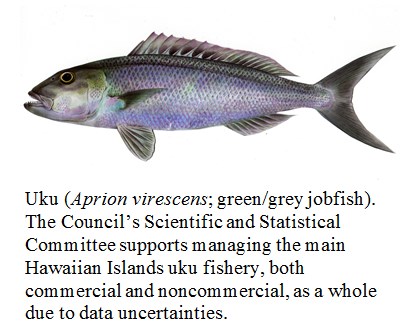News and Announcements
Press Release – Scientists Support Combined Management Measures for Uku, Review Mitigation Tactics for False Killer Whales (15 June 2021)
 HONOLULU (15 June 2021) The Scientific and Statistical Committee (SSC) of the Western Pacific Regional Fishery Management Council supported the combined management of the commercial and noncommercial sectors of the main Hawaiian Islands (MHI) uku fishery. Commercial fishery data is submitted mandatorily through monthly reports. However, variabilities in the noncommercial data from the voluntary Hawai‘i Marine Recreational Fisheries Survey (estimated bi-monthly) raise uncertainties about the reliability of this system as a tool for in-season tracking against the annual catch limit. Improvements in data collection systems and establishing a proper management framework for sector allocation are required if the uku fishery is to be managed separately.
HONOLULU (15 June 2021) The Scientific and Statistical Committee (SSC) of the Western Pacific Regional Fishery Management Council supported the combined management of the commercial and noncommercial sectors of the main Hawaiian Islands (MHI) uku fishery. Commercial fishery data is submitted mandatorily through monthly reports. However, variabilities in the noncommercial data from the voluntary Hawai‘i Marine Recreational Fisheries Survey (estimated bi-monthly) raise uncertainties about the reliability of this system as a tool for in-season tracking against the annual catch limit. Improvements in data collection systems and establishing a proper management framework for sector allocation are required if the uku fishery is to be managed separately.In September 2020, the SSC set the acceptable biological catch for uku at 297,624 pounds for fishing years 2022 to 2025. The MHI stock is not overfished or subject to overfishing.
The Committee noted that the decision whether to use sector allocation of the total annual catch target is purely a management action. A 2020 stock assessment from the Pacific Island Fisheries Science Center indicates that noncommercial fishers harvest smaller fish compared to commercial fishers due to fishing location and gear type differences. From a scientific standpoint, this justifies managing the uku fishery separately. The SSC chair suggested that the group conduct a risk analysis to determine if management measures should be different for the two sectors in the future.
—
A working group of the SSC highlighted their preliminary findings on alternative approaches to reduce impacts to false killer whales (FKWs) in the Hawai‘i deep-set longline fishery. The draft issues paper reviews the history of the Pacific Islands Region FKW Take Reduction Team and their recommendations, past SSC recommendations, cetacean avoidance research and interaction reduction measures, among other topics.
The group suggested, for example, that mitigation strategies should focus on removing the trailing gear from an accidentally hooked FKW instead of using weak circle hooks, which to date have proved ineffective. Also, they noted there is not enough demographic information, such as survival rates at different ages and reproductive rates, to do a population assessment or diagnose trends for FKWs. The working group will work with the full Committee to review the findings and associated recommendations.
The meeting continues through Thursday, June 17, 2021. Instructions on connecting to the web conference, agenda and briefing documents are posted at www.wpcouncil.org/event/140th-scientific-and-statistical-committee-virtual-meeting.
Scientific and Statistical Committee: James Lynch (Sierra Pacific Industries) (chair); Debra Cabrera (University of Guam); Frank Camacho (University of Guam); Milani Chaloupka (University of Queensland); Erik Franklin (University of Hawai‘i, School of Ocean and Earth Science and Technology); Shelton Harley (Minister of Fisheries, NZ); Jason Helyer (Hawai‘i Division of Aquatic Resources); Ray Hilborn (University of Washington); Justin Hospital (National Marine Fisheries Service (NMFS) PIFSC); David Itano (fisheries consultant); Donald Kobayashi (NMFS PIFSC); Steve Martell (SeaState, Inc.); Domingo Ochavillo (American Samoa Dept. of Marine and Wildlife Resources); Graham Pilling (Secretariat of the Pacific Community); Kurt Schaefer (Inter-American Tropical Tuna Commission); Craig Severance (University of Hawai‘i at Hilo, retired); Michael Tenorio (CNMI Division of Fish and Wildlife); and Michael Seki (ex-officio) (NMFS PIFSC).
Click here for printable PDF.
